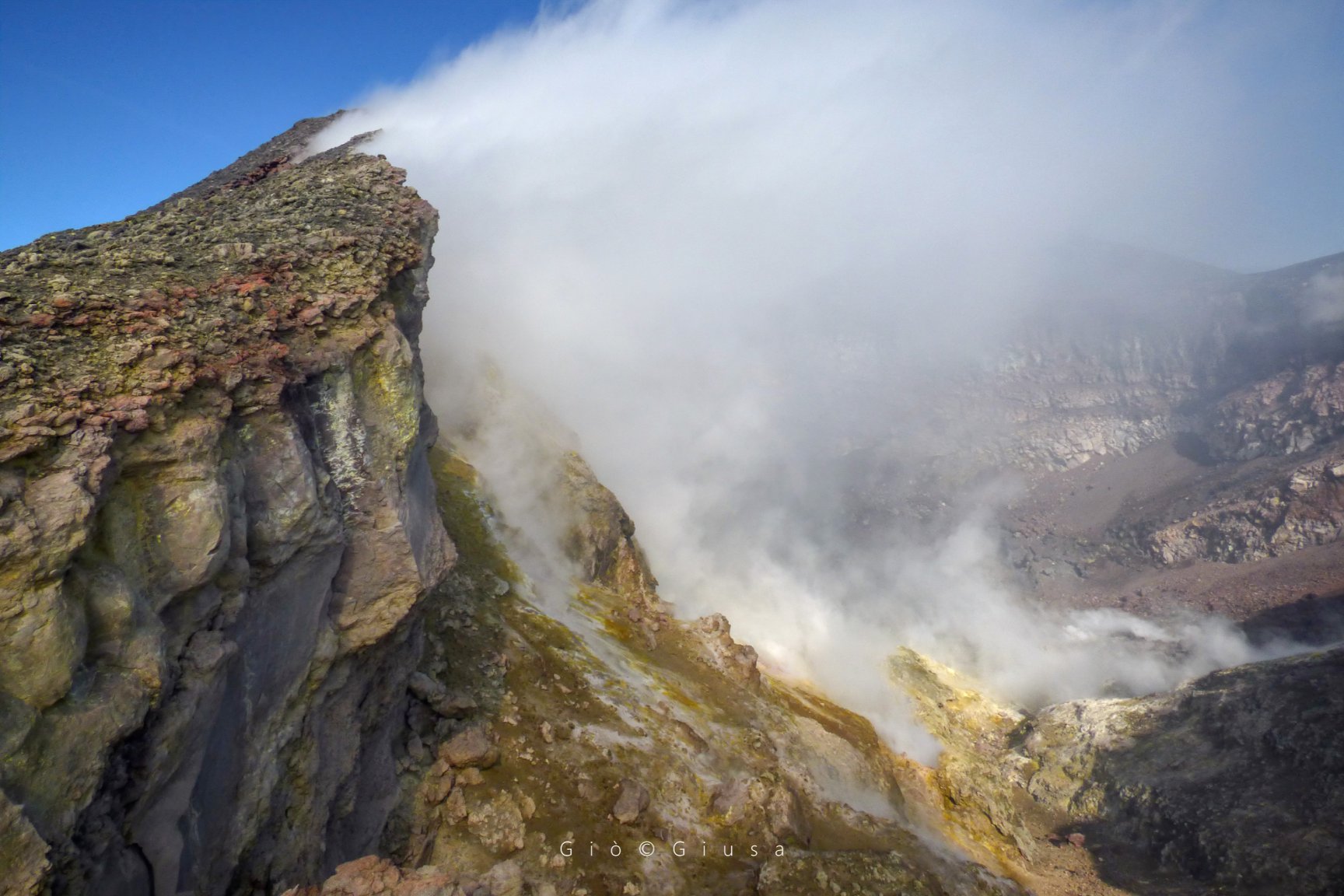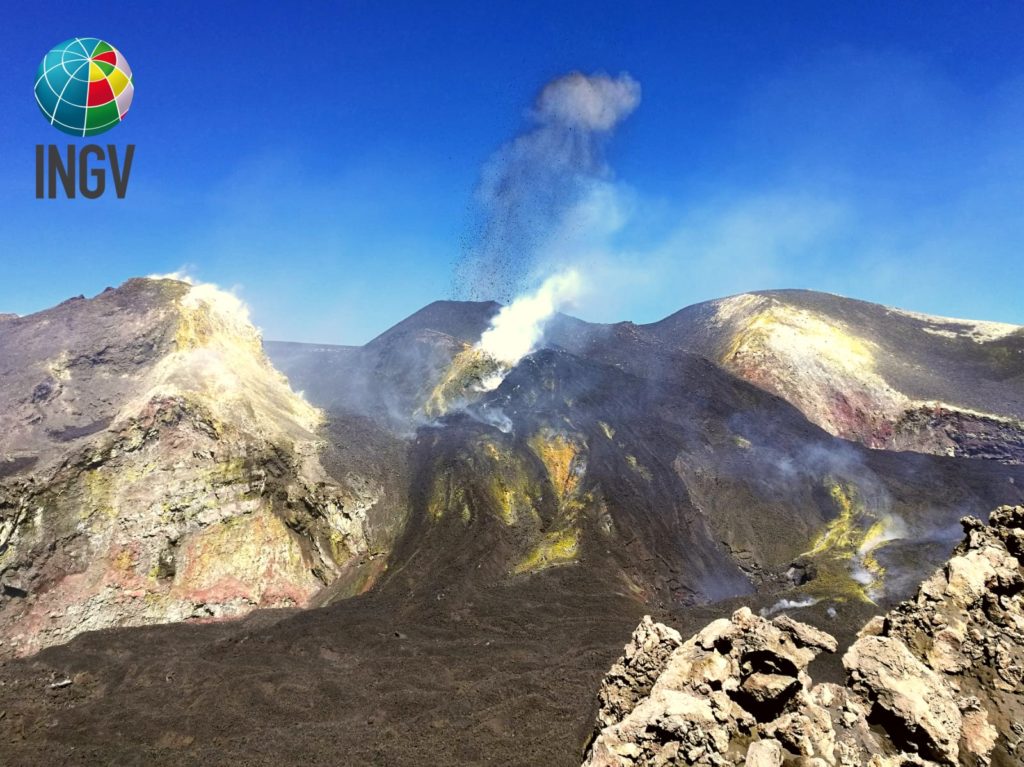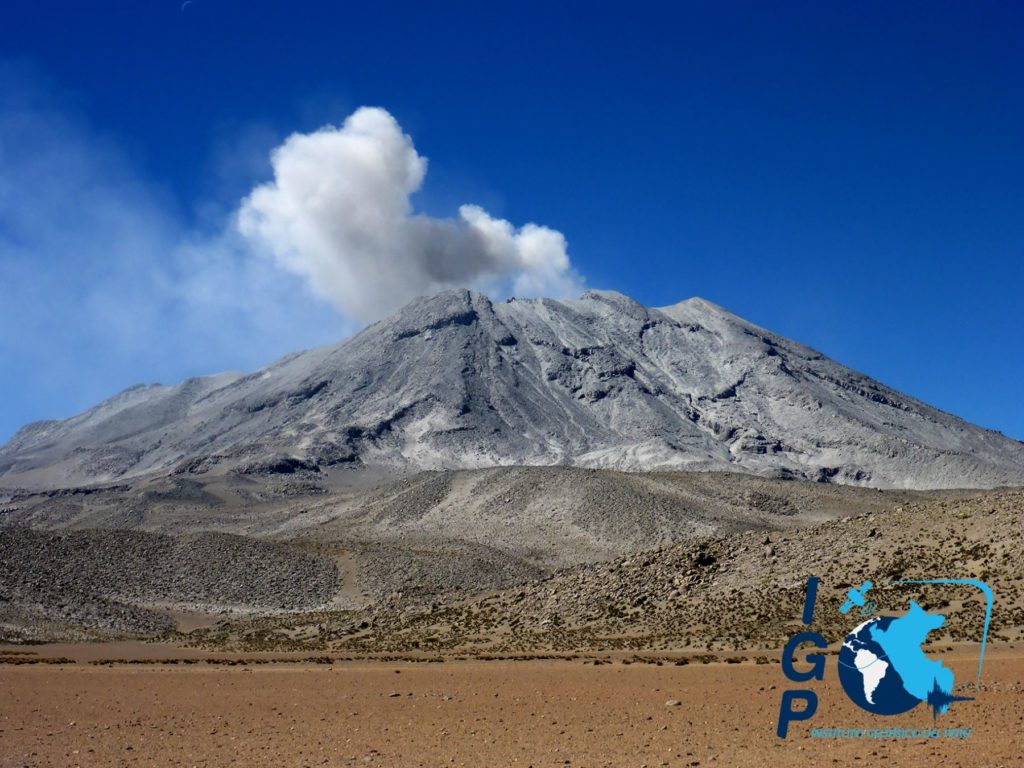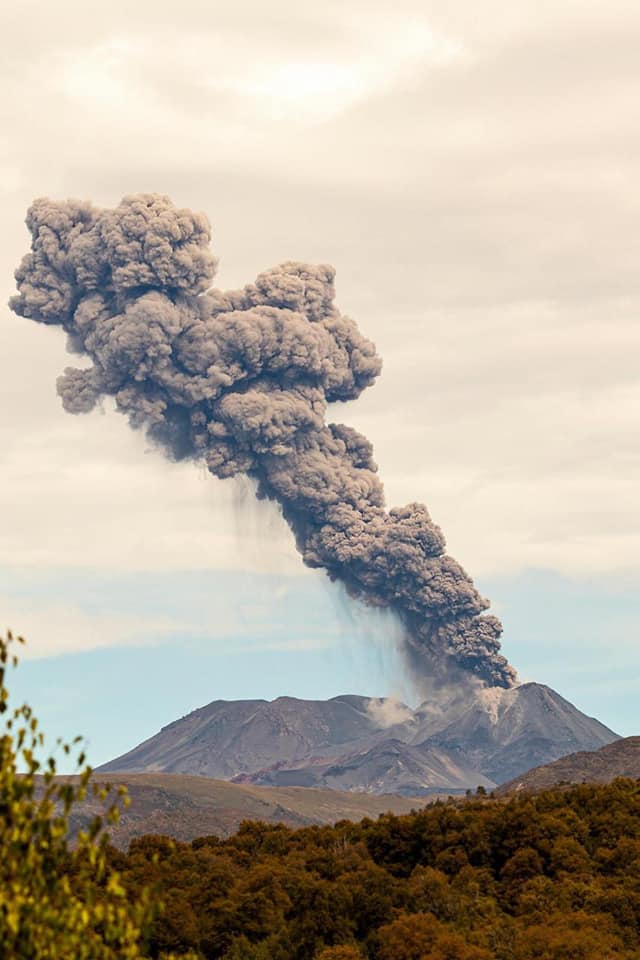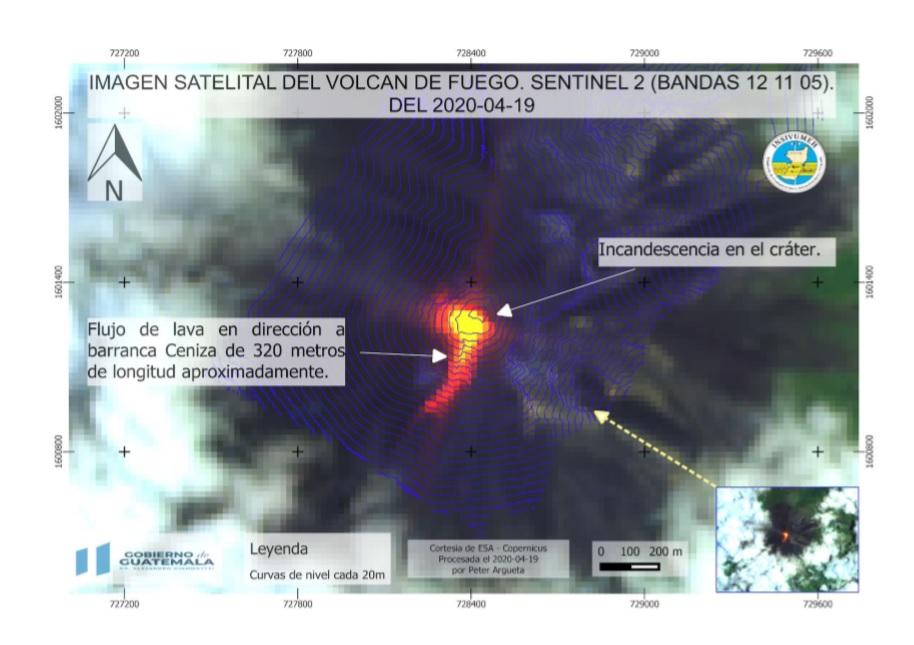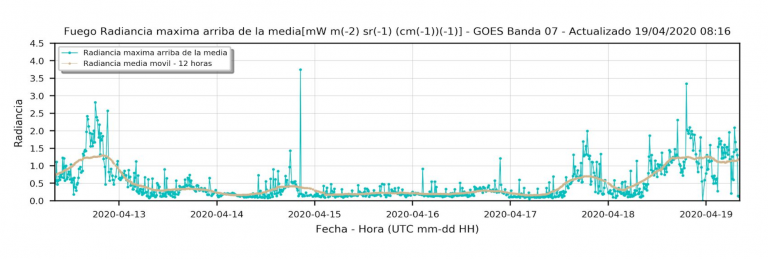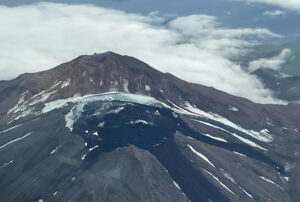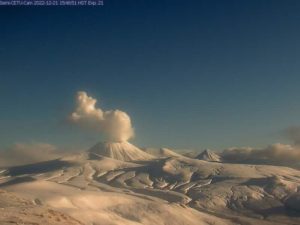April 22 , 2020 .
Italy / Sicily , Etna :
Weekly bulletin from 04/13/2020 to 04/19/2020. (issue date 04/21/2020).
SUMMARY OF ACTIVITY STATUS
In light of the monitoring data, it is highlighted:
1) VOLCANOLOGICAL OBSERVATIONS: Strombolian and effusive intra-crater activity of the Voragine crater. Strombolian activity and modest lava fountain activity in the Southeast crater. Degassing and explosive intra-crater activity of the North-East crater.
2) SEISMOLOGY: Modest seismic fracturing activity; high values of the amplitude of the volcanic tremor.
3) INFRASONS: Moderate activity.
4) DEFORMATIONS: The GPS (HF) network did not show any significant variation. During the eruptive activity of April 19, the inclinometric network showed minimal variations compared to the usually recorded trends, more visible at the stations near the crater area.
5) GEOCHEMISTRY: the flow of SO2 is at a medium-low level. Soil CO2 flow values are medium-high values. The partial pressure of dissolved CO2 does not show significant variations. The isotopic ratio of helium is fixed at medium-high values (last update of 2/14/2020). No update is available for the C / S report
6) SATELLITE OBSERVATIONS: The thermal activity in the summit area is of medium-high level.
VOLCANOLOGICAL OBSERVATIONS.
During the week, monitoring of Etna activity was carried out using the network of surveillance cameras from the INGV – Section of Catania Osservatorio Etneo (INGV-OE) and by means of three inspections in the summit area carried out by INGV-OE staff on April 17, 18 and 19. On the whole, the state of activity of the upper craters during the observation period was characterized by the continuation of the explosive and effusive activity which takes place in the crater of Voragine, by a brief episode of activity strombolian and a modest lava fountain activity from the New Southeast Crater on April 19 and a degassing regime, of varying intensity, in the Northeast crater, accompanied by explosive intra crater activity.
The eruptive activity of April 19 began around 06:30 UTC with the start of Strombolian activity in the New Crater of Southeast (NCSE) which, from 07:15 UTC, gradually evolved into a modest lava fountain. The activity involved one or two mouths in the « saddle cone » area (formed in spring 2017) and generated an ash emission which at the beginning was rather soft, but which from 08:45 UTC approximately, has seen its intensity gradually increase. The eruptive activity generated a plume which rose up to about 5 km above sea level, pushed towards the eastern quadrants of the volcano by the prevailing winds. The ashes fell on the east side of the volcano, mainly in the Valle del Bove, but the fall of fine materials was also reported in the areas of Etna located between the inhabited areas of Zafferana Etnea (Southeast side) and Linguaglossa (North-East side). From 09:55 UTC, it was possible to observe that the activity of the lava fountains gradually decreased until it stopped, just as the emission of ash gradually weakened. During the inspection carried out in the afternoon of Sunday, April 19, a few bombs were sampled, produced by the activity of the lava fountain, at an altitude of 3070 m, about 100 m downstream from the NCSE saddle mouthpiece. A projection of about 50 m wide was also found, with 3-4 small rheomorphic flows which fell from the edge of the crater but did not exceed the area.
Interior of the North-East Crater (1911), one of the 4 summit craters at the top of Mount Etna with its 3320 m.
Regarding the Voragine crater, Strombolian activity started in September 2019 continues with slight fluctuations compared to what has been reported so far. During the inspections on Friday 17 and Saturday 18 April, the explosive activity observed in the Voragine crater was mainly carried by the main cone, active since September 12, 2019, with a frequency and intensity lower than those observed in the previous days. In particular, on Saturday 18, the explosive activity appeared almost continuous from the cone located east-south-east of the main cone, while it was more sporadic from the main cone. The effusive activity of the mouth at the base of the main cone covered about 30 m. towards the crater of Bocca Nuova then stopped, while the depression inside the crater of Bocca Nuova appears a little wider than in the previous observations. Concerning – finally – the North-East crater, during the April 19 inspection, loud shards were heard distinctly, probably from the mouth at the bottom of the crater observed during the April 10 inspection and described in the bulletin April 14, but no release of pyroclastic material was observed.
Source : INGV .
Read the whole article : http://www.ct.ingv.it/joomlatools-files/docman-files/multidisciplinari/BollettinoEtna20200421.pdf?fbclid=IwAR1gS5scONS4d_NATFkKMjLZBK0cmmFXEzCvskMX_gvtIhWbNI97NYv669I
Video : INGV.
Photos : Francesco Ciancitto, INGV-Observatoire Etnéen , Gio Giusa .
Peru , Ubinas :
Analysis period: April 13 to 19, 2020. Arequipa, April 20, 2020.
Alert level: ORANGE
The Geophysical Institute of Peru (IGP) reports that the dynamic behavior of the Ubinas volcano remains at low levels. To date, the recording of earthquakes associated with the ascent of the magma towards the surface is rare. There are light and sporadic emissions of blue gases (of magmatic origin) and water vapor. According to this scenario, the possibility of the appearance of explosions and / or ash emissions is low.
Between April 13 and 19, the IGP recorded and analyzed a total of 28 seismic events associated with the dynamic behavior of the Ubinas volcano, with the predominance of seismic signals of the Volcano-Tectonic type (VT), related to the fracturing of rocks inside the volcano. On average, 4 earthquakes were recorded per day with magnitudes below M1.2. There was no seismic activity linked to the rise of magma (hybrid type).
Surveillance cameras recorded light and sporadic emissions of volcanic gases and water vapor, with heights less than 300 m above the summit of the volcano. Monitoring the deformation of the volcanic structure does not record any significant anomalies. MIROVA satellite monitoring did not record any thermal anomalies.
Source : IGP.
Chile , Nevados of Chillan :
Special report on volcanic activity (REAV) Ñuble Region, Nevados de Chillán Volcanic Complex, April 21, 2020, 1:48 p.m. Local time (mainland Chile).
The National Geological and Mining Service of Chile (Sernageomin) publishes the following PRELIMINARY information, obtained thanks to the surveillance teams of the National Volcanic Surveillance Network (RNVV), processed and analyzed at the South Andean Volcanological Observatory (Ovdas):
Yesterday Tuesday, April 21 at 1:33 p.m. local time (5:33 p.m. UTC), the monitoring stations installed near the Nevados de Chillán Volcanic Complex recorded an explosion associated with the dynamics of fluids in the volcanic system with emission of gases and particles.
The characteristics of the earthquake after its analysis are as follows:
TIME OF ORIGIN: 13:33 local time (17:33 UTC)
LATITUDE: 36 867 ° S
LENGTH: 71.377 ° W
DEPTH: 0.3 km
REDUCED DISPLACEMENT: 180 (cm * cm)
ACOUSTIC SIGNAL: 10 Pascals (Pa) reduced to 1 km
In addition, the characteristics of the associated surface activity are as follows:
MAXIMUM COLUMN HEIGHT: 2380 meters above the point of emission
DIRECTION OF DISPERSION: South-East (SE)
The volcanic technical alert remains at the YELLOW level.
Source : Sernageomin.
Photo : Chillan Viejo Chile.
Guatemala , Fuego :
Special volcanological bulletin.
Updated by Flavio Emmanuel Muñoz Barrera on April 20, 2020, 10:22 a.m. local time
CHANGE OF ERUPTIVE MODEL WITH EFFUSIVE ACTIVITY, VOLCANO DE FUEGO (1402-09)
On the night of April 18 of the current year, the INSIVUMEH network of seismic stations and acoustic sensors recorded a change in the eruptive pattern of the Fuego Volcano. A new lava flow towards the Ceniza ravine with a length of about 320 meters has been observed from today with satellite images. This activity is accompanied by an almost constant incandescence in the crater and avalanches which go up to 1 km and reach the vegetation. This stream can be extended in length and can even be extended to other ravines. Weak and moderate explosions are also observed and recorded which generate rumblings, shock waves and columns of ash up to 4800 m altitude (15,748 feet). The current activity is similar to that recorded on April 7, 2020, which lasted approximately 7 days.
Fig 1: Satellite image, Volcan Fuego, from April 19, 2020.
The climatic conditions of yesterday and today did not allow to visualize the lava flow from the observatory of the Fuego volcano, however the analysis of satellite images allows to obtain the characteristics of the lava flow (figure 1). You should be aware of its evolution.
It is possible that during the night hours, a strong glow is observed in the cities close to the volcano and that the train-type train noises linked to the expulsion of magmatic material are prolonged longer.
The glow values over the past 24 hours (Figure 2) reflect that the lava flow started to form last night and was fed with magmatic material and thus maintained its length.
RECOMMENDATIONS FOR THIS INSIVUME ACTIVITY TO SE-CONRED: Do not stay near or in the ravines around the volcano. Effusive activity can intensify and even extend to another ravine, it is therefore recommended to communicate or inform about this activity to populations close to the volcano, mainly in the Ceniza ravine.
Source : Insivumeh.

